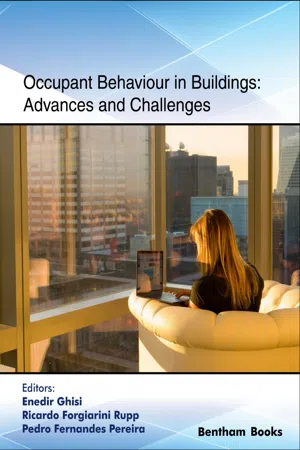
Occupant Behaviour in Buildings: Advances and Challenges
- English
- ePUB (mobile friendly)
- Available on iOS & Android
Occupant Behaviour in Buildings: Advances and Challenges
About This Book
Occupant behaviour in buildings is a point of interest for building designers around the world. Functional buildings have a significant energy demand; therefore, improving the thermal and energy performance of such buildings requires knowledge about the variables that influence them. However, to increase the potential for improving thermal and energy performance of buildings, studies must also consider the occupant's interactions with the built environment. The occupant behaviour influences the conditions of the internal environment through the occupation of indoor building spaces and through the interaction with building elements, such as air-conditioning, lighting, blinds and windows. Occupant Behaviour in Buildings: Advances and Challenges brings together reviews of these influential aspects, presenting updates on advances and questions that pose challenges in our current understanding of behavioural modeling and its application to building design. Special topics covered in the book include methods to survey occupant behavior, building design choices, occupant behaviour impact on a building's thermal and energy efficiency, and, finally, a simulation of occupants in a building. Key Features- Presents up-to-date information on occupant behaviour in buildings- Eight chapters, written by renowned researchers, provide readers with useful insights on the subject- Includes a case study of buildings in Brazil- Structured reader-friendly content- References for further reading This reference is an informative resource for students and professionals in architecture, civil engineering, building information design, and urban planning. Readers interested in social and behavioural sciences will also gain insights on research methods that are helpful in investigating human behavior in urban dwellings.
Frequently asked questions
Information
Indoor Climate Management of Museums: the Impact of Ventilation on Conservation, Human Health and Comfort
Hugo Entradas Silva1, *, Fernando M. A. Henriques1
Abstract
* Corresponding author Hugo Entradas Silva: Departamento de Engenharia Civil, Faculdade de Ciências e Tecnologia, FCT, Universidade NOVA de Lisboa, 2829-516 Caparica, Portugal; Tel: +351 964356293; E-mail: [email protected]
Introduction
Table of contents
- Welcome
- Table of Content
- Title
- BENTHAM SCIENCE PUBLISHERS LTD.
- PREFACE
- List of Contributors
- Exploring The Potential of Combining Technological Innovations with Qualitative Methods in Occupant Behaviour Research
- Monitoring Occupant Window Opening Behaviour in Buildings: A Critical Review
- Supporting the Decision-making Process of Building Users in the Selection of Energy-Efficient Heating Solutions by Identifying and Evaluating Co-benefits
- The Impact of Occupants in Thermal Comfort and Energy Efficiency in Buildings
- Detecting Occupant Actions in Buildings and the Drivers of Their Behaviour
- The (Not So) Close Relationship Between Occupancy and Windows Operation
- Investigating the Uncertainties of Occupant Behaviour in Building Performance Simulation: A Case Study in Dwellings in Brazil
- Indoor Climate Management of Museums: the Impact of Ventilation on Conservation, Human Health and Comfort